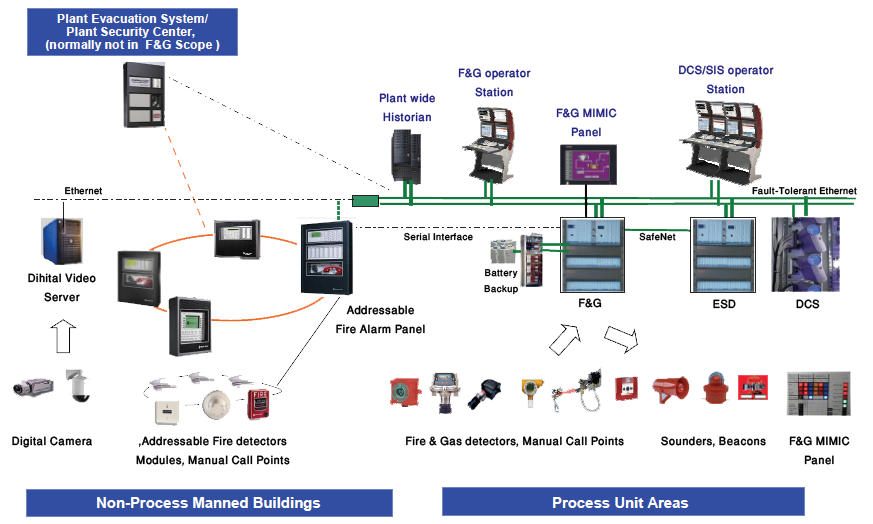Fire and Gas System or F&G System continuously monitors for abnormal situations such as a fire, or combustible or toxic gas release within the plant; and provides early warning and mitigation actions to prevent escalation of the incident and protect the process or environment. By implementing an integrated Fire and Gas strategy based on the latest automation technology, plants can meet their plant safety and critical infrastructure protection requirements while ensuring operational and business readiness at project start-up.
The objective of Fire & Gas Detection system is to:
- Minimize the risk and consequences of an accidental event.
- Minimize the potential for hazardous occurrences
- Ensure a safe working environment for personnel
- Ensure adequate means of escape are provided
- Provide sufficient safety devices and redundancy to detect, isolate and minimize uncontrolled releases of flammable and toxic liquids and gases.
- Provide appropriate fire protection systems to rapidly bring under control and extinguish any reasonably foreseeable fire which could develop during normal operations.
- Minimize the potential for pollution of the environment from accidental spills, venting or flaring of hazardous materials.
The F&G system is used for automating emergency actions with a high-integrity safety and control solution to mitigate further escalation. It is also important for recovering from abnormal situations quickly to resume full production.
A typical F&G safety system comprises detection, logic control and alarm and mitigation functions. Control Panel is the central control unit of the overall F&G detection and control system. The controller receives alarm and status or analog signals from field monitoring devices required for Fire and Gas detection. The controller handles the required actions to initiate alarms and mitigate the hazard.
Fire and gas detection devices have developed greatly over recent years. Using new techniques and adding intelligence to these instruments to reduce the number of spurious alarms has greatly improved detection rates. Correct and proven connection of fire and gas detectors to plant safety systems is an important factor in reliable performance of the F&G system and for establishing the desired Safety Integrity Level (SIL).
Today, F&G detection systems are generally Programmable Electronic Systems (PES) type with high safety availability and mitigation effectiveness. As modern F&G systems are tightly integrated with the overall process safety strategy, mitigation either takes place via the Emergency Shutdown (ESD) system or directly from the F&G system itself.
Components of a Fire and Gas System |
| A good F&G system combines innovative fire and gas detectors, conventional and analog addressable fire panels, clean agent and inert gas fire suppression systems, and a SIL-certified fire and gas Control Panel into a consistently designed and executed solution. An integrated system provides common tools, operating interface and networking, resulting in a common platform with independent systems. F&G systems can detect early warnings of explosive and health hazards, including combustible and toxic gas releases, thermal radiation from fires and minute traces of smoke in sensitive equipment enclosures. They also provide audible and visual alarm indications helping to ensure operators and personnel are informed of potentially hazardous situations. The F&G system automatically initiates executive actions minimizing escalation of safety incidents and protecting personnel, property and the environment. Integration at the controller level provides plant-wide Safety Instrumented System (SIS) point data, diagnostics and system information, as well as alarms and events, operator displays and sequence of event information to any station. This minimizes intervention and shutdowns, reduces hardware costs, and allows plants to recover more easily from process upsets. The new generation of fire & gas solutions provides alerts of abnormal situations in a fast, accurate and structured way, giving personnel time to decide upon the correct course of action. These solutions include new integration capabilities with process simulation tools, F&G detectors and control communication protocols, enabling safety engineers to design and build large integrated and distributed plant-wide safety strategies. Overall SIS technology integrates safety measures dispersed throughout a plant to reduce risk to employees and assets, increase process availability, and improve regulatory compliance. SIS solutions can be integrated with fire & gas detectors for increased protection, and unified with third-party applications and systems to reduce validation and acceptance testing costs. Modern safety systems, seamlessly integrated with the plant automation system through a secure communication network, transfer alarm signals, fault signals and system diagnostics. Information from all related systems can be transferred, gathered and handled at the same location, and an additional layer can be achieved to monitor the status and operability of the total F&G detection and control system. |
 |
Our Services
SISICO is able to offer an extensive range of Fire and Gas Systems and other related systems to suit your specific environment.

